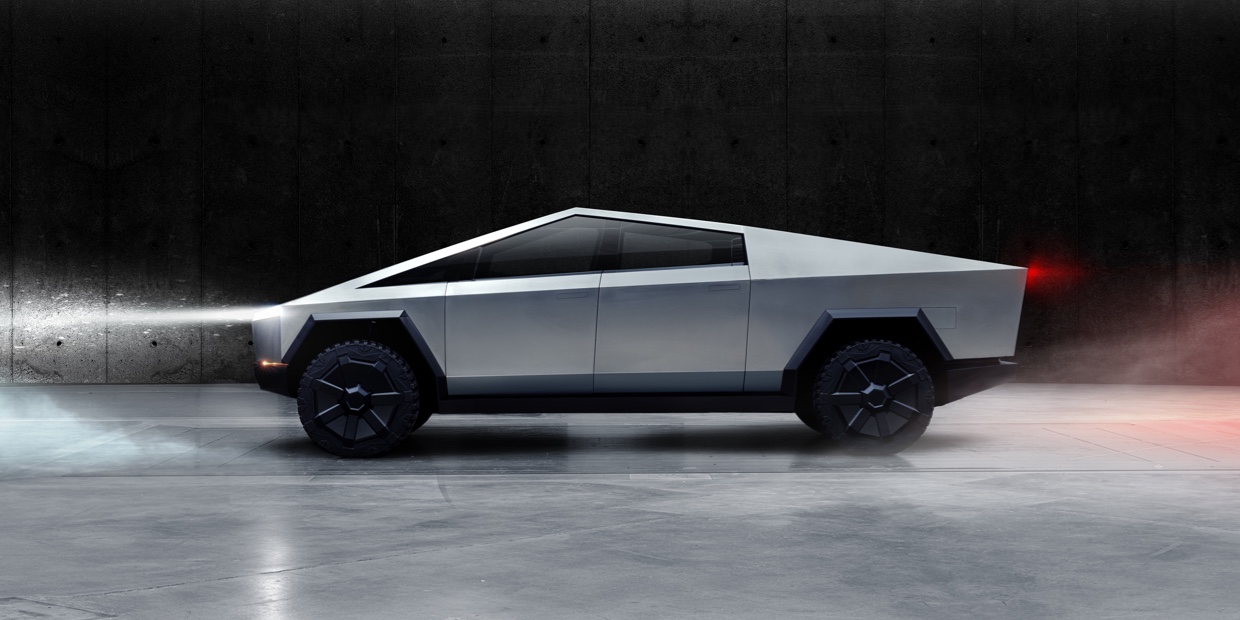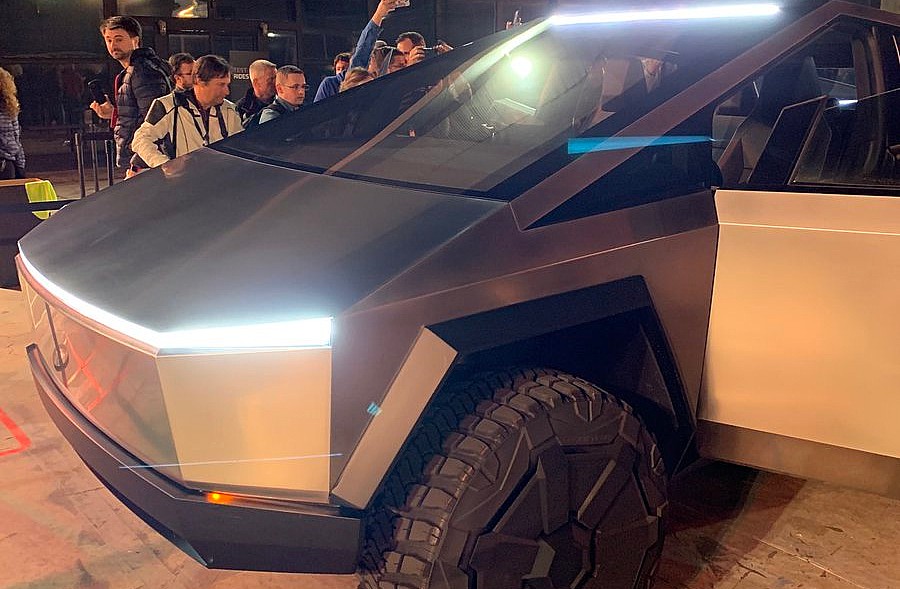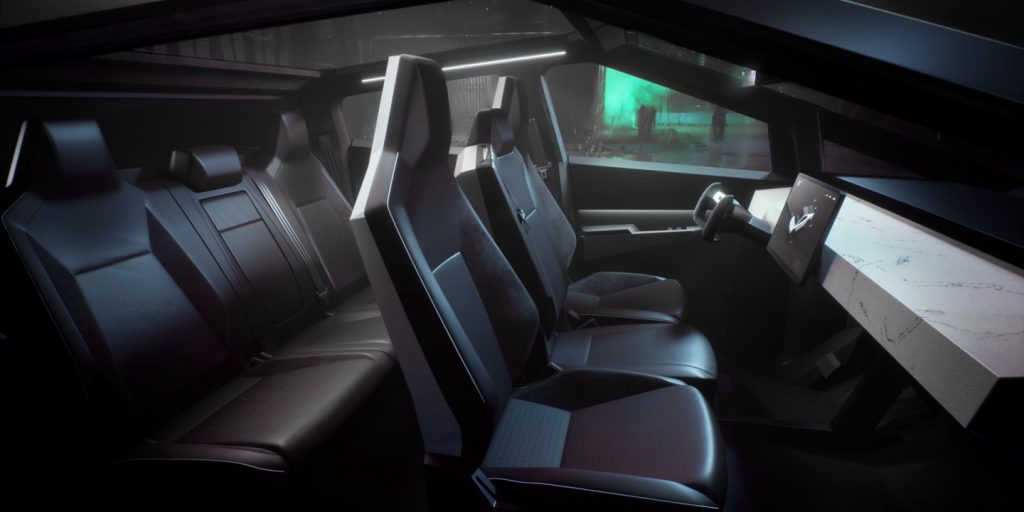

News
Tesla’s Cybertruck is not a bet-the-company vehicle, and it should scare TSLA critics
The Tesla (NASDAQ:TSLA) Cybertruck’s unveiling event could have easily gone better, with the vehicle’s disruptive specs and pricing pretty much getting pushed to the background by media coverage of the pickup’s less-than-stellar Armor Glass demonstration. Cracked windows aside, the fact remains that the Cybertruck starts at $39,990, a price that’s as aggressive as the vehicle’s almost brutalist design. It’s also a price that shows that Tesla is at a point where it actually can experiment and be bolder than usual. This should scare TSLA critics.
The Cybertruck is a massive vehicle, as long as a Ford F-150 and far more powerful as teased by the company’s tug-of-war demo that it briefly showed during the pickup’s unveiling. It’s also unapologetically futuristic, with a 17″ landscape infotainment screen that’s not found in any of Tesla’s other vehicles. It has pop-out door handles that are directly inspired by the premium-priced Model S as well. And these are just the tip of the iceberg, as the Cybertruck has a ton of other features and capabilities that make it a great vehicle for work and play.
Yet, the monster of a truck that Tesla unveiled starts at a price that’s just slightly above the base price of the Model 3 sedan. There was a reason why gasps could be heard at the vehicle’s unveiling when the Cybertruck’s pricing was revealed. Elon Musk has noted during his interview with Tesla owner-enthusiast Ryan McCaffrey last June that the Cybertruck will start at $49,000 at the most. Absolutely no warning was given that Tesla was going for a far more aggressive starting price, especially considering the vehicle’s built-in tech such as its adaptive suspension and basic Autopilot capabilities.

The fact that the Cybertuck is designed in such a polarizing manner suggests that Tesla has some funding to spare. By releasing such a vehicle, the electric car maker has shown the auto market that it is at a point where it can be bold and take ridiculous risks such as releasing a truck that looks nothing like a conventional pickup. Elon Musk has admitted as much, noting during an appearance at veteran tech journalist Kara Swisher’s Recode Decode podcast that if the Cybertruck were to fail, Tesla will make a more conventional truck. Musk’s words then, spoken over a year ago, rings true today.
“I’m personally super-excited by this pickup truck. It’s something I’ve been wanting to make for a long time. And I’ve been iterating sort of designs with Franz. If there’s only a small number of people that like that truck, I guess we’ll make a more conventional truck in the future. I think this is the kinda thing the consumer would want to buy, even if they don’t normally buy a pickup truck. So, anyway, that’s personally I’m most excited about. But like I said, it could be just like, okay, I weirdly like it and other people don’t. That’s possible. But we’re gonna make it anyway, and then we will just have a niche audience, I don’t know. But if it does, then we’ll make a more conventional pickup truck,” Musk said.

Tesla has, for the most part over the years, operated with limited resources. Elon Musk is a risk-taker, and some of these were so notable that they were considered as “bet-the-company” situations. The Model 3 was one of these, with Musk noting that if the all-electric sedan were had failed, it would have likely ruined Tesla for good. Considering the bold direction that the company took with the Cybertruck, as well as Elon Musk’s statements last year, it definitely appears that the all-electric monster pickup that Tesla just unveiled is not a bet-the-company vehicle. It is a truck that would be great if it succeeded, but it is also a vehicle that could be replaced if it were to fail.
This should be a chilling thought for Tesla critics, particularly those who feverishly wait for the next quarter’s numbers in their excitement to see TSLA stock drop. After all, if the Cybertruck were to fail and if Tesla were to make a conventional pickup truck, there is a good chance that the company’s more traditional truck would be even more aggressively priced. Such a pickup would likely outperform diesel-powered rivals as well in classic Tesla fashion as well. Such a truck, combined with Tesla’s ever-growing charging infrastructure and its ever-evolving Autopilot system, would have the potential to clean house in a manner that is not as kind as the Cybertruck, which will always be polarizing.
Tesla is a resilient company, one that weathered one of the worst financial crises in recent history, and it’s led by a man that’s hell-bent on pushing sustainable transportation by proving that electric cars are better in every way than fossil fuel-powered vehicles. It’s best to note that a Tesla with limited resources has proven that it can still disrupt established industries with well-designed, safe, and feature-rich electric cars. A Tesla with resources to spare? That’s a downright frightening idea if one is a TSLA critic.
Disclosure: I have no ownership in shares of TSLA and have no plans to initiate any positions within 72 hours.

News
Nvidia CEO Jensen Huang explains difference between Tesla FSD and Alpamayo
“Tesla’s FSD stack is completely world-class,” the Nvidia CEO said.

NVIDIA CEO Jensen Huang has offered high praise for Tesla’s Full Self-Driving (FSD) system during a Q&A at CES 2026, calling it “world-class” and “state-of-the-art” in design, training, and performance.
More importantly, he also shared some insights about the key differences between FSD and Nvidia’s recently announced Alpamayo system.
Jensen Huang’s praise for Tesla FSD
Nvidia made headlines at CES following its announcement of Alpamayo, which uses artificial intelligence to accelerate the development of autonomous driving solutions. Due to its focus on AI, many started speculating that Alpamayo would be a direct rival to FSD. This was somewhat addressed by Elon Musk, who predicted that “they will find that it’s easy to get to 99% and then super hard to solve the long tail of the distribution.”
During his Q&A, Nvidia CEO Jensen Huang was asked about the difference between FSD and Alpamayo. His response was extensive:
“Tesla’s FSD stack is completely world-class. They’ve been working on it for quite some time. It’s world-class not only in the number of miles it’s accumulated, but in the way it’s designed, the way they do training, data collection, curation, synthetic data generation, and all of their simulation technologies.
“Of course, the latest generation is end-to-end Full Self-Driving—meaning it’s one large model trained end to end. And so… Elon’s AD system is, in every way, 100% state-of-the-art. I’m really quite impressed by the technology. I have it, and I drive it in our house, and it works incredibly well,” the Nvidia CEO said.
Nvidia’s platform approach vs Tesla’s integration
Huang also stated that Nvidia’s Alpamayo system was built around a fundamentally different philosophy from Tesla’s. Rather than developing self-driving cars itself, Nvidia supplies the full autonomous technology stack for other companies to use.
“Nvidia doesn’t build self-driving cars. We build the full stack so others can,” Huang said, explaining that Nvidia provides separate systems for training, simulation, and in-vehicle computing, all supported by shared software.
He added that customers can adopt as much or as little of the platform as they need, noting that Nvidia works across the industry, including with Tesla on training systems and companies like Waymo, XPeng, and Nuro on vehicle computing.
“So our system is really quite pervasive because we’re a technology platform provider. That’s the primary difference. There’s no question in our mind that, of the billion cars on the road today, in another 10 years’ time, hundreds of millions of them will have great autonomous capability. This is likely one of the largest, fastest-growing technology industries over the next decade.”
He also emphasized Nvidia’s open approach, saying the company open-sources its models and helps partners train their own systems. “We’re not a self-driving car company. We’re enabling the autonomous industry,” Huang said.
Elon Musk
Elon Musk confirms xAI’s purchase of five 380 MW natural gas turbines
The deal, which was confirmed by Musk on X, highlights xAI’s effort to aggressively scale its operations.

xAI, Elon Musk’s artificial intelligence startup, has purchased five additional 380 MW natural gas turbines from South Korea’s Doosan Enerbility to power its growing supercomputer clusters.
The deal, which was confirmed by Musk on X, highlights xAI’s effort to aggressively scale its operations.
xAI’s turbine deal details
News of xAI’s new turbines was shared on social media platform X, with user @SemiAnalysis_ stating that the turbines were produced by South Korea’s Doosan Enerbility. As noted in an Asian Business Daily report, Doosan Enerbility announced last October that it signed a contract to supply two 380 MW gas turbines for a major U.S. tech company. Doosan later noted in December that it secured an order for three more 380 MW gas turbines.
As per the X user, the gas turbines would power an additional 600,000+ GB200 NVL72 equivalent size cluster. This should make xAI’s facilities among the largest in the world. In a reply, Elon Musk confirmed that xAI did purchase the turbines. “True,” Musk wrote in a post on X.
xAI’s ambitions
Recent reports have indicated that xAI closed an upsized $20 billion Series E funding round, exceeding the initial $15 billion target to fuel rapid infrastructure scaling and AI product development. The funding, as per the AI startup, “will accelerate our world-leading infrastructure buildout, enable the rapid development and deployment of transformative AI products.”
The company also teased the rollout of its upcoming frontier AI model. “Looking ahead, Grok 5 is currently in training, and we are focused on launching innovative new consumer and enterprise products that harness the power of Grok, Colossus, and 𝕏 to transform how we live, work, and play,” xAI wrote in a post on its website.
Elon Musk
Elon Musk’s xAI closes upsized $20B Series E funding round
xAI announced the investment round in a post on its official website.

xAI has closed an upsized $20 billion Series E funding round, exceeding the initial $15 billion target to fuel rapid infrastructure scaling and AI product development.
xAI announced the investment round in a post on its official website.
A $20 billion Series E round
As noted by the artificial intelligence startup in its post, the Series E funding round attracted a diverse group of investors, including Valor Equity Partners, Stepstone Group, Fidelity Management & Research Company, Qatar Investment Authority, MGX, and Baron Capital Group, among others.
Strategic partners NVIDIA and Cisco Investments also continued support for building the world’s largest GPU clusters.
As xAI stated, “This financing will accelerate our world-leading infrastructure buildout, enable the rapid development and deployment of transformative AI products reaching billions of users, and fuel groundbreaking research advancing xAI’s core mission: Understanding the Universe.”
xAI’s core mission
Th Series E funding builds on xAI’s previous rounds, powering Grok advancements and massive compute expansions like the Memphis supercluster. The upsized demand reflects growing recognition of xAI’s potential in frontier AI.
xAI also highlighted several of its breakthroughs in 2025, from the buildout of Colossus I and II, which ended with over 1 million H100 GPU equivalents, and the rollout of the Grok 4 Series, Grok Voice, and Grok Imagine, among others. The company also confirmed that work is already underway to train the flagship large language model’s next iteration, Grok 5.
“Looking ahead, Grok 5 is currently in training, and we are focused on launching innovative new consumer and enterprise products that harness the power of Grok, Colossus, and 𝕏 to transform how we live, work, and play,” xAI wrote.








